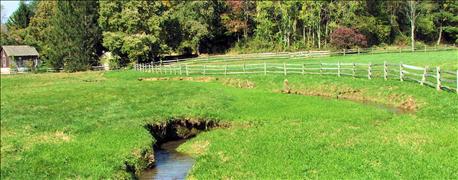
There's a remedy for those small streams eroding steep bank walls through pastures, and carrying sediment who knows where. Plant tree "cover crops".
Research by the Stroud Water Research Center, Avondale, Pa., confirms that a wooded buffer zone bordering a stream can protect water quality plus maintain the stream's natural structure and habitat. Now, the not-so-good news.
Those streamside forest buffers should be at least 100 feet wide on each side to adequately protect freshwater ecosystems from human activities, says Bernard Sweeney, director of the center. “That’s a lot. We know it’s a lot. But this is what the science is saying, and the reward for a wide forest buffer is huge.”

Steeply cut banks of this small stream give way to a wider, slower flow as it moves from the meadow into a forested buffer. (Photo courtesy of Stroud Water Research Center/David Funk)
Reward? Trees are the best streamside cover crops, contends Sweeney. "They have more capacity to prevent and remove nitrogen and sediment pollutants.
"Forested streams are cooler during dry summers with more algae and aquatic herbivores (including fish). They also have more variety of foods – leaves, twigs, berries and more." Woody debris in a stream is good habitat.
Meadows and grass buffers don't provide as many benefits. Black flies or biting flies are signs of a stream that's not in good condition. And, just one bad farm can kill stream quality for miles, he adds.
One reason for WOTUS
U.S. EPA's final rules for redefining "waters of the United States" target small streams, for good reason. “Most pollutants enter river systems in small streams narrow enough to jump across. So it’s vitally important that we protect their function,” explains Denis Newbold, research scientist also at the Chester County center.
Small freshwater systems constitute 85% or more of the total stream miles in the world, he adds. And, they're more commonly in direct contact with human pollution sources than larger freshwater creeks and rivers. In 2013, EPA reported that more than half of U.S. river and stream miles were no longer able to support natural aquatic life or designated use by humans.
~~~PAGE_BREAK_HERE~~~
Historically, streamside forests formed the natural interface between hill slopes and aquatic processes for most watersheds. Even streams on grassland prairies were often bordered by forest.
Rainfall generally returns to underground aquifers and streams via those slopes. That's why streamside forests play in protecting and enhancing water quality of downstream rivers and estuaries.
How wide to work?
Current standards for a minimum forest buffer width vary by state and even programs. Recommendations range from 35 to 100 feet.
State and federal incentives offset at least part of forest buffer establishment. “Not every farmer and landowner we work with can accommodate a 100-foot wide forest buffer," acknowledges Matt Ehrhart, Stroud's director of watershed restoration. But understanding forest buffers' importance may help "persuade landowners to establish wider forest buffers than they might previously have considered.”
–Vogel is editor of sister publication American Agriculturist
About the Author(s)
You May Also Like




